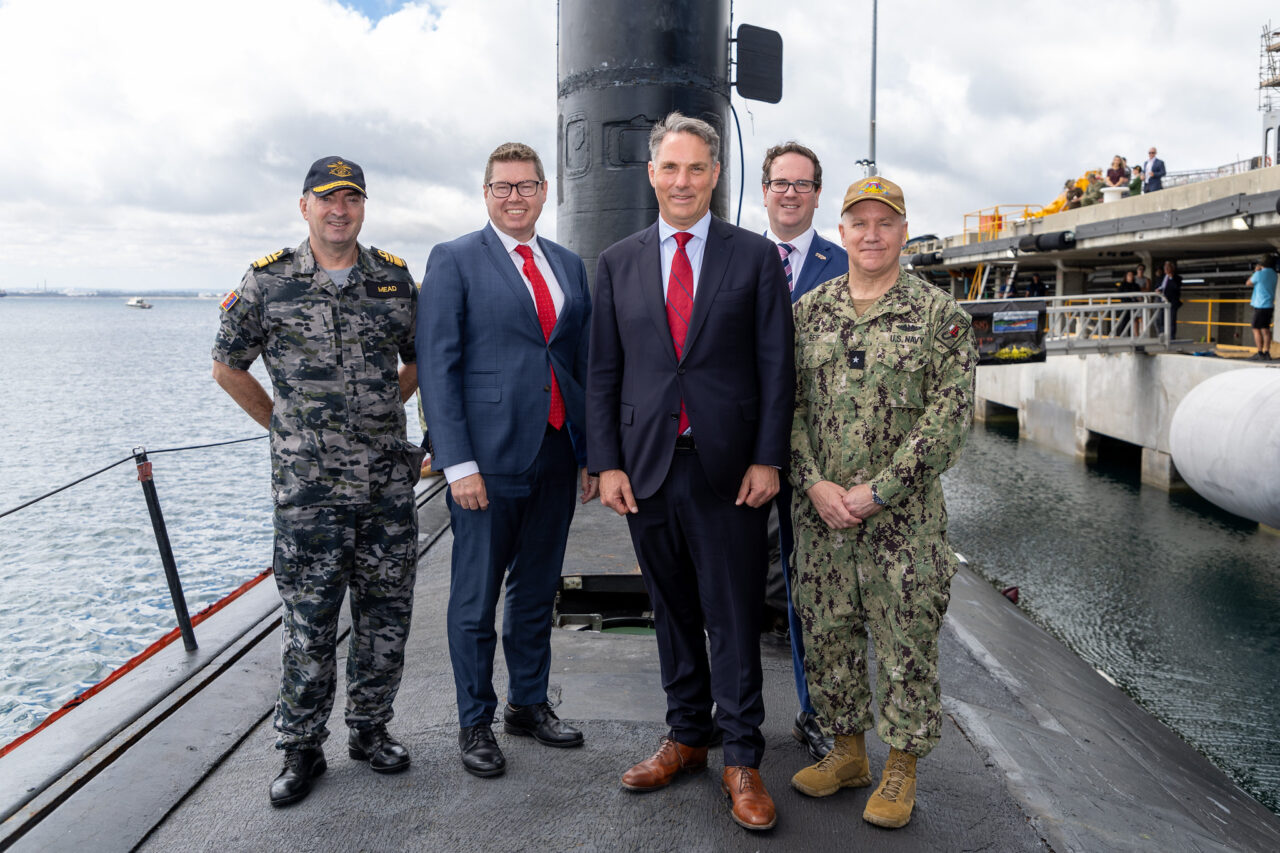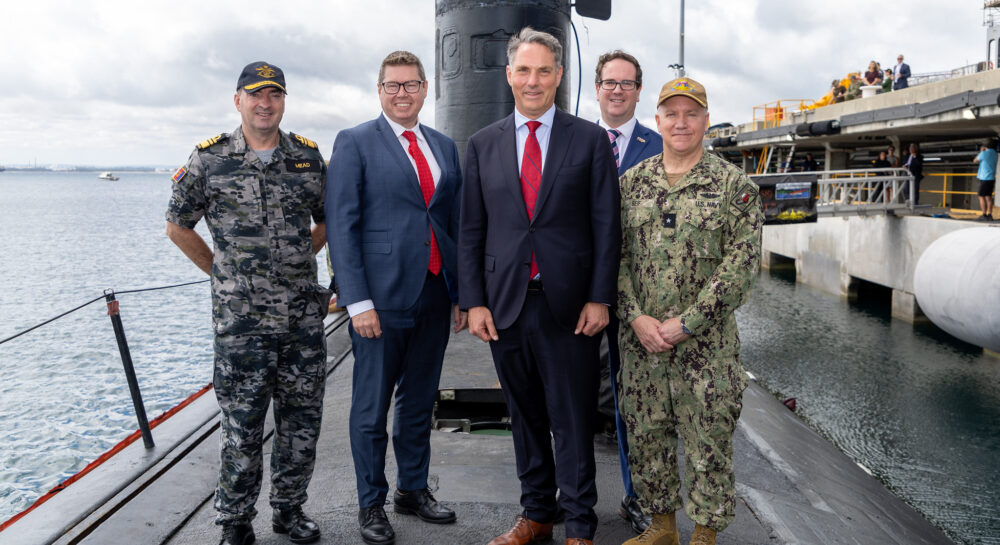AUKUS boosters in the federal government and beyond like to point out that the nuclear submarine pact between Canberra, Washington and London will create 20,000 jobs in Australia. At about $18 million per job, it’s one of the worst job creation programs in history.
Instead, Professor Al Rainnie from the University of South Australia argues we should fight for jobs that are meaningful for our lives, not dependent on militarism and the war machine.

Defence Minister Richard Marles (centre) and Defence Industry Minister Pat Conroy (second left) on USS Asheville at HMAS Stirling in WA. Photo: US Indo-Pacific Command/Flickr
Doug Cameron, delivering the 2025 Carmichael Lecture for the Centre for Future Work, pointed out that the Albanese government remains, tragically, deeply invested in AUKUS.
The Morrison-driven origins of AUKUS were dubious, to put it mildly. Its justification in terms of containing Chinese influence in the South China sea, making Australia a prime US forward base, was a marker of the New Cold War. Cameron pointed to the deep doubts about the ability of both the US and UK submarine construction facilities to build enough nuclear submarines to satisfy the agreement. This despite Australia providing billions of dollars in downpayment this year alone to pay for accelerated production schedules in both the US and the UK.
Addressing members of the Federal Parliamentary Labor Party, Cameron asked where the peace activists in the caucus are, where the local members looking after the peace and prosperity of local members were? He asked whether those on the left of the party had rejected common sense and fallen in line with US hegemony and imperialism.
Against AUKUS
Cameron, who is a national patron of Labor Against War, is not alone in his concerns. For example, more than 40 local organisations in the Illawarra have issued the Port Kembla Declaration, calling on the government to rule out Port Kembla, NSW, as a location for a nuclear submarine base under the AUKUS deal.
I work with an organisation, PACOA, in South Australia that opposes any AUKUS development in Port Adelaide and Enfield, despite a huge construction site emerging at Outer Harbour to house the new assembly. We have organised public meetings in Port and demonstrations on the steps of the South Australian Parliament.
But we face a tide of propaganda from state and federal government, backed up by local and national media. A lot of it is focussed on the supposed job creating potential of AUKUS. This is important for areas like Taperoo, on the AUKUS doorstep in Port Adelaide, which is one of the poorest areas in South Australia.
In areas like Taperoo, the inflated promise of jobs is used to disguise the meagre reality of development potential, never mind the nuclear waste.
To begin with, there are the simple over-the-top exaggerations from leading Labor politicians. Pat Conroy, Minister for Defence Industry, argued that AUKUS would be the greatest industrial undertaking ever in Australia and would transform SA. Albanese suggested that AUKUS would have a similar impact on South Australia as the car industry had in the post-World War II period.
Equally outrageous claims are being made about the job creating potential of developments at Henderson, the $127m defence precinct for servicing AUKUS submarines near Perth in Western Australia. It is claimed that this will employ around 10,000 skilled workers and “rival the resources industry in Western Australia”, according to WA Premier, Roger Cook. British Aerospace recently announced more than 150 job losses at the Henderson precinct. Not a promising picture.
To add insult to injury, the federal government has promised public housing for up to 1200 US military personnel, but struggles to provide housing solutions for Australian citizens.
On the quality of jobs front, it is also worth noting the British Aerospace Systems workers at the Osborne Naval Shipyard have been on strike regularly in recent months, claiming that they are paid well below industry standards.
A Barrow load of nonsense
As I have argued at length in an article in the Journal of Australian Political Economy, the Osborne development is highly unlikely to create large numbers of jobs. Furthermore, as the experience of BAE Systems Submarines construction in Barrow-in-Furness in northwest England has made abundantly clear, the development is a more akin to a ‘Cathedral in the Desert’, having little impact on the local economy.
In 2023, the Financial Times claimed that AUKUS would provide a jobs bonanza for Osborne and Barrow-in-Furness. However, in reporting the Barrow case, the article provided the first hint that building submarines has not been an unalloyed positive for the Cumbrian town. The prospect of steady long-term investment was meant to promise a “reprieve from the ‘feast or famine’ cycle that has historically dogged submarine manufacturing in the UK”. The town itself has experienced long-term population decline, and in 2020 Barrow was ranked 146 out of 181 non-metropolitan districts in England by gross domestic product.
Greens Senator David Shoebridge has argued that, in Barrow, the nuclear subs program provides very steady employment for a small number of people, but:
While it’s a lovely town, Barrow-in-Furness shows that the nuclear subs do not build a vibrant high-technology economy outside the walls of the defence industry … Those spin-offs the Prime Minister hopes for are not much in evidence.
The Cumbrian Local Enterprise Partnership Report for 2022 pointed to strong islands of very innovative firms operating in competitive global sectors but often with few links to other Cumbrian firms. The only ‘innovative’ firms that the report pointed to were BAE Systems and the decommissioned Windscale Nuclear Power Plant, isolated islands of dubious development.
In NSW, the South Coast Labour Council has been clear in its opposition to turning Port Kembla into an AUKUS east coast base. Instead it and a coalition of union affiliates and environment advocacy organisations have campaigned for an Illawrra Renewable Energy Zone.
Renewable energy investment has far greater economic multipliers in local economies than military investment, which operate isolated from the communities they are based in, often turning them into military targets, instead.
Building an alternative
For Port Adelaide and Osborne, the lesson is that it would be wise to treat all claims regarding job growth and related local economic development with a large pinch of salt.
On top of this, South Australia, like the rest of the country, is facing a massive skills shortage. We must campaign for jobs that we desperately need and an education system fit to provide them. A few examples will help.
Housing We know that we have a crisis of affordable housing, never mind homelessness itself. However, the Master Builders Association has forecast a shortage of 130,000 workers across building and construction in 2024 alone. A significant number of these desperately needed skilled workers are currently employed constructing the huge site in Osborne. We need these workers elsewhere, right now.
Electricity workforce The Australian Energy Market Operator has argued that Australia will need a 33,000 addition to the electricity workforce by 2029. The vast majority of these jobs would be in renewable industries. We are already falling behind our woefully inadequate emissions reduction targets. We need these skilled workers focused on rewiring the nation, and electrifying Australia.
Recycling Currently, around four million homes have installed solar amounting to around 150 million panels. As I found out when I had a new battery and panels put on my roof, most of those panels are destined for stockpile, landfill or are sent overseas. Around four million panels a year are decommissioned and that is expected to rise to around eight million. We have no significant recycling industry capable of dealing with this problem, and the federal government’s Future Made in Australia strategy has no room for recycling on this scale. Up to 85 percent of raw materials inside solar panels could be recycled but simply aren’t being or won’t be in the future under current strategy.
Our hopelessly inadequate recycling infrastructure certainly won’t be able to cope with the wave of batteries being installed alongside these solar panel systems.
Green steel Another great example of where resources would be better allocated is the Whyalla steelworks. If the steelworks is to migrate to green steel it will require vast amounts of scrap metal. In the disastrous and unforgiveable Northwest Shelf oil and gas expansion, one ray of sunshine is 5.7 million tonnes (equivalent to 110 Sydney Harbour Bridges worth) of steel in the shape of oil and gas infrastructure that will need decommissioning in the next two decade.
Australia does not have a large-scale decommissioning site capable of dealing with this critical mass. Without a dedicated decommissioning plant and downstream processing, decommissioning will either go to other countries, or the existing sites will be given over to ‘re-reefing’, which is environmentally disastrous. An optimal site had been identified south of Perth, in the Henderson shipping building precinct. However, as we have seen, it has been set aside for AUKUS. Apparently servicing nuclear submarines which will not turn up any time soon, if at all, is far more important than preventing environmental disaster.
Recycling and decommissioning are vital but also would provide an abundance of skilled, well-paid jobs now and into the future.
These would all be jobs for life, in every sense of the word.
Capturing education
The defence industries have ‘captured’ the debate and, along with it, massive influence over the organisations and institutions (including governments) that will drive our future. In South Australia, AUKUS is being promoted in schools, TAFE and in the universities, despite public meetings being organised to oppose the ‘Militarisation of Education’. As Alison Broinowski pointed out in ARENA in 2023:
Upgrading our universities and TAFE colleges to produce graduates with the skills to do things and produce goods that Australia needs now, and to fill employment vacancies, would make more sense than training people to make lethal weapons.
It has been good to see the NSW Teachers Federation push back, its members refusing to promote the ‘Nuclear Submarines Challenge’ and boycott similar pro AUKUS programs in schools.
Conclusion
We desperately need a community-based campaign that is not justagainst AUKUS, but for what we could and should have instead. Future Made in Australia should be focused on renewables, communities and fighting climate change, not ‘securonomics’ and the New Cold War. We need a union- and community-led campaign for what we could and should have, right here, right now.
This article draws on arguments developed in my forthcoming book with Darryn Snell and Mark Dean.
Snell, D., Dean M., Rainnie A. Australia’s Regional and Industrial Future: Beyond Militarisation and Green Capitalism. Routledge (2026 forthcoming)

